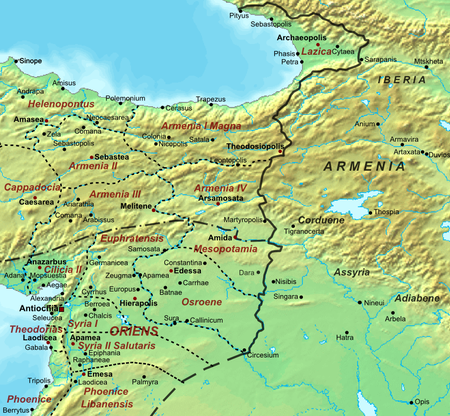
Year 582 (DLXXXII) was a common year starting on Thursday of the Julian calendar. The denomination 582 for this year has been used since the early medieval period, when the Anno Domini calendar era became the prevalent method in Europe for naming years.

Al-Ḥārith ibn Jabalah, was a king of the Ghassanids, pre-Islamic Arabs who lived on the eastern frontier of the Byzantine Empire. The fifth Ghassanid ruler of that name, he reigned from c. 528 to 569 and played a major role in the Roman–Persian Wars and the affairs of the Syriac Orthodox Church. For his services to Byzantium, he was made patrikios and vir gloriosissimus.
The Battle of Solachon was fought in 586 CE in northern Mesopotamia between the East Roman (Byzantine) forces, led by Philippicus, and the Sassanid Persians under Kardarigan. The engagement was part of the long and inconclusive Byzantine–Sassanid War of 572–591. The Battle of Solachon ended in a major Byzantine victory which improved the Byzantine position in Mesopotamia, but it was not in the end decisive. The war dragged on until 591, when it ended with a negotiated settlement between Maurice and the Persian shah Khosrau II.

The Byzantine–Sasanian wars, also known as the Irano-Byzantine wars refers to a series of conflicts between the Eastern Roman (Byzantine) Empire and the Sassanian Empire of Persia. A continuation of the Roman–Persian Wars, the conflict involved several smaller campaigns and peace treaties lasting for years at a time.

The Byzantine–Sasanian War of 572–591 was a war fought between the Sasanian Empire of Persia and the Eastern Roman Empire, termed by modern historians as the Byzantine Empire. It was triggered by pro-Byzantine revolts in areas of the Caucasus under Persian hegemony, although other events contributed to its outbreak. The fighting was largely confined to the southern Caucasus and Mesopotamia, although it also extended into eastern Anatolia, Syria, and northern Iran. It was part of an intense sequence of wars between these two empires which occupied the majority of the 6th and early 7th centuries. It was also the last of the many wars between them to follow a pattern in which fighting was largely confined to frontier provinces and neither side achieved any lasting occupation of enemy territory beyond this border zone. It preceded a much more wide-ranging and dramatic final conflict in the early 7th century.
Philippicus or Philippikos was an East Roman general, comes excubitorum, and brother-in-law of Emperor Maurice. His successful career as a general spanned three decades, chiefly against the Sassanid Persians.
John, surnamed Mystacon, "the mustachioed",, was a prominent East Roman (Byzantine) general in the wars with Sassanid Persia during the reigns of Byzantine emperors Tiberius II and Maurice.
Kardarigan was a Sassanid Persian general of the early 7th century, who fought in the Byzantine-Sassanid War of 602–628. He is usually distinguished from another Persian general of the same name who was active during the 580s. The name is actually an honorific title and means "black hawk".
Shahraplakan, rendered Sarablangas (Σαραβλαγγᾶς) in Greek sources, was a Sassanid Persian general who participated in the Byzantine-Sassanid War of 602–628.
Cours or Curs, also known as Coursos, Cursos, Qwrys, Crous or Crus, was an East Roman (Byzantine) general of the 6th century.
Hermogenes was an East Roman (Byzantine) official who served as magister officiorum, military commander and diplomatic envoy during the Iberian War against Sassanid Persia in the early reign of Emperor Justinian I.
Theodore was the brother of the Byzantine emperor Heraclius, a curopalates and leading general in Heraclius' wars against the Persians and against the Arab invasions.
Gubazes II was king of Lazica from circa 541 until his assassination in 555. He was one of the central personalities of the Lazic War (541–562). He originally ascended the throne as a vassal of the Byzantine Empire, but the heavy-handed actions of the Byzantine authorities led him to seek the assistance of Byzantium's main rival, Sassanid Persia. The Byzantines were evicted from Lazica with the aid of a Persian army in 541, but the Persian occupation of the country turned out to be worse, and by 548, Gubazes was requesting assistance from Byzantium. Gubazes remained a Byzantine ally during the next few years, as the two empires fought for control of Lazica, with the fortress of Petra as the focal point of the struggle. Gubazes eventually quarrelled with the Byzantine generals over the fruitless continuation of the war, and was assassinated by them.
Mihr-Mihroe, in Middle Persian either Mihr-Mihrōē or Mihrmāh-rōy; in Byzantine sources Mermeroes, was a 6th-century Sassanid Persian general, and one of the leading commanders of the Byzantine–Sassanid Wars of the time.
The Perpetual Peace, signed in 532 between the East Roman (Byzantine) Empire and Sassanid Persia, was a peace treaty of indefinite duration, which concluded the Iberian War (527–531) between the two powers. It heralded a period of relatively cordial relations, but lasted only until 540, when hostilities resumed over the control of Lazica.

Arbāyistān was a Sasanian province in Late Antiquity. Due to its situation and its road systems, the province was a source of income from commercial traffic, as well as a constant area of contention during the Roman-Persian wars.











